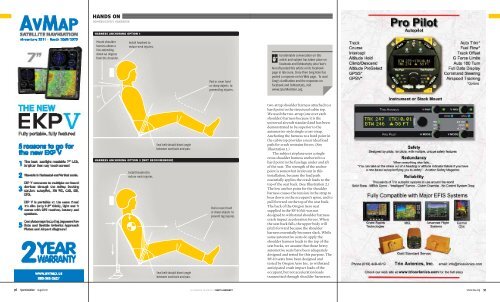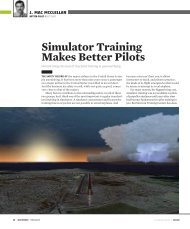August issue of Sport Aviation by Van's founder Dick ... - Left Seat
August issue of Sport Aviation by Van's founder Dick ... - Left Seat
August issue of Sport Aviation by Van's founder Dick ... - Left Seat
You also want an ePaper? Increase the reach of your titles
YUMPU automatically turns print PDFs into web optimized ePapers that Google loves.
HANDS ON<br />
HOMEBUILDER’S HANDBOOK<br />
Harness Anchoring Option 1<br />
Mount shoulder<br />
harness above a<br />
line extending<br />
down 40 degrees<br />
from the shoulder.<br />
Install headrest to<br />
reduce neck injuries.<br />
Pad or cover hard<br />
or sharp objects to<br />
prevent leg injuries.<br />
Considerable conversation on this<br />
article and subject has taken place on<br />
Facebook and Oshkosh365 since Van’s<br />
Aircraft posted this article on its Facebook<br />
page in late June. Since then Greg Hale has<br />
posted a response on his Web page. To read<br />
Greg’s clarification and the responses on<br />
Facebook and Oshkosh365, visit<br />
www.<strong>Sport</strong><strong>Aviation</strong>.org.<br />
40˚<br />
Harness Anchoring Option 2 (not recommended)<br />
Install headrest to<br />
reduce neck injuries.<br />
<strong>Seat</strong> belt should bisect angle<br />
between seat back and pan.<br />
<strong>Seat</strong> belt should bisect angle<br />
between seat back and pan.<br />
Pad or cover hard<br />
or sharp objects to<br />
prevent leg injuries.<br />
two-strap shoulder harness attached to a<br />
hard point in the structural cabin top.<br />
We used the two-strap (one over each<br />
shoulder) harness because it is the<br />
universal aircraft standard and has been<br />
demonstrated to be superior to the<br />
automotive-style single cross-strap.<br />
Anchoring the harness to a hard point in<br />
the cabin top provides a near ideal load<br />
path for crash restraint forces. (See<br />
Illustration 1.)<br />
The subject airplane uses a single<br />
cross shoulder harness anchored to a<br />
hard point in the fuselage under and aft<br />
<strong>of</strong> the seat. The strength <strong>of</strong> the anchor<br />
point is somewhat irrelevant in this<br />
installation, because the load path<br />
essentially applies the crash loads to the<br />
top <strong>of</strong> the seat back. (See Illustration 2.)<br />
The low anchor point for the shoulder<br />
harness causes the tension in the strap to<br />
bear down on the occupant’s spine, and to<br />
pull forward on the top <strong>of</strong> the seat back.<br />
The back <strong>of</strong> the Oregon Aero seat<br />
supplied in the RV-10 kit was not<br />
designed to withstand shoulder harness<br />
crash impact acceleration forces. When<br />
the seat back fails, the upper body will<br />
pitch forward because the shoulder<br />
harness essentially becomes slack. While<br />
some automotive seats do apply the<br />
shoulder harness loads to the top <strong>of</strong> the<br />
seat backs, we assume that those heavy<br />
automotive seats have been adequately<br />
designed and tested for this purpose. The<br />
RV-10 seats have been designed and<br />
tested <strong>by</strong> Oregon Aero Inc. to withstand<br />
anticipated crash impact loads <strong>of</strong> the<br />
occupant, but not acceleration loads<br />
transmitted through shoulder harnesses.<br />
96 <strong>Sport</strong> <strong>Aviation</strong> <strong>August</strong> 2011 illustration courtesy <strong>of</strong> Van’s Aircraft<br />
www.eaa.org 97




